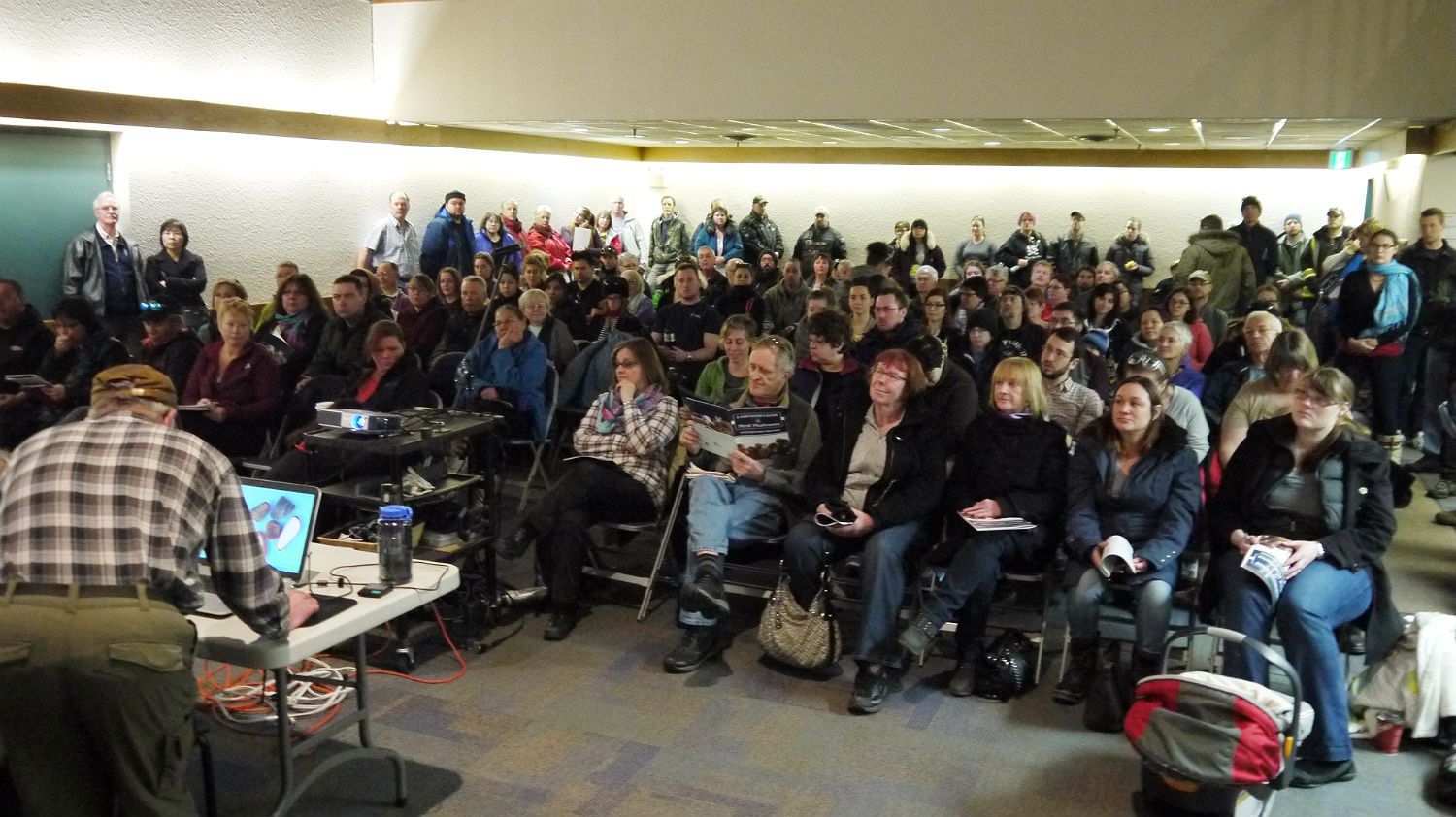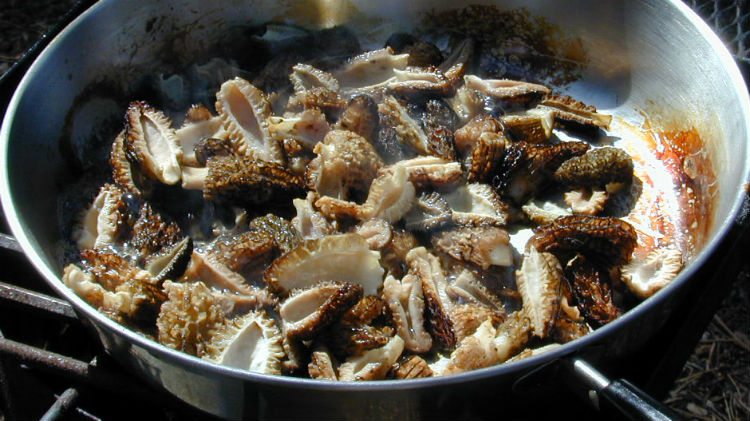Updated 4/20/2015: The Northwest Territories could be about to have its biggest-ever morel mushroom season, according to some experts.
The mushrooms, which flourish in burnt areas left behind by forest fires, are sought-after delicacies.
Growing season brings hundreds of people up from the south, camped out along highways in a bid to make a small fortune harvesting mushrooms.
However, this year – with a huge crop expected in the aftermath of last year’s bad fire season – the territory is trying to prepare its own residents to take advantage of the harvest.
Read: Territory launches workshops to avoid morel dilemma
Workshops and briefings are being held across the NWT to inform people about what to expect and how mushroom harvesting works.
Moose FM attended a session in Yellowknife at the end of March with biologist and mushroom expert Joachim Obst, while Ecology North’s Kim Rapati attended an earlier session in Hay River, led by long-time NWT mushroom pickers Bruce Green and Walter Brown. Kim has kindly let us share her notes below.
New, 4/20/2015: We have added links to several recent articles examining safety while mushroom picking and new companies being established to harvest mushrooms (and keep the profits in the NWT).
In late March, we added more information from the latest territorial government sessions, held on March 31 in Yellowknife. Also, scroll down for a link to a new version of the territory’s morel mushroom harvesting handbook.
Latest morel mushroom articles
In April, the Workers’ Safety and Compensation Commission warned people about the safety responsibilities they may have while out harvesting. Make sure you take the advice on board if you’re heading out.
We also heard from Mycelium, a new company formed by a Fort Providence mushroom harvester alongside a top Edmonton chef. The company aims to keep all its profits from this year’s harvest in the NWT, using local workers – our article includes contact details, which may help if you’d like to be involved in the harvest but are unsure where to start.
Finally, the CBC has compiled an article looking at the potential dangers of arsenic contamination in mushrooms found within a 50km radius of Yellowknife. The advice is: don’t pick any mushrooms (morels or otherwise) within that radius.
In practice there are not expected to be many (if any) good morel-harvesting areas within that radius, but be sure to travel at least 50km west of the city if heading out to the North Slave’s burn areas.
Moose FM’s notes from a Yellowknife session (late March 2015)
How are the prices looking right now?
Don’t get too carried away – while people were earning $14-plus per pound of fresh morel mushrooms last year, prices could be up to 50 per cent lower this summer.
That’s because ideal conditions for mushrooms exist elsewhere in Canada and the world right now, not just in the NWT. So there could be a big global harvest, which will keep prices down if supply exceeds demand.
Mushroom harvesting expert Joachim Obst reckons you might only get $6.50 to $8 per pound of mushrooms this year, but it could be higher, depending on conditions here and elsewhere.
One idea is to check the prices on eBay each week, to get an idea of how prices are fluctuating and where they’re at right now.
What if we have another bad forest fire season?
That is an important consideration. If the wildfires are bad again this year, it may be that many of the best harvesting areas are inaccessible – or they go up in flames. (It’s perfectly possible for these burn areas to burn again. In some cases, millions of dollars in mushrooms may literally go up in smoke.)
You should hope for a warm, damp summer for the best growing conditions.

Where can I harvest?
Consult the territorial government guidebook – there’s a link at the bottom of this page – for more information. It’s really important that you get this right and know where you can and cannot harvest, and who is in charge of each parcel of land. Ask the territorial government using the contacts in the guidebook if you are not sure.
You certainly shouldn’t pick mushrooms near the highway, because they may be too contaminated to sell. Also avoid using mosquito spray – mushrooms have been turned away in the past, after European buyers found they had been contaminated by the chemicals found in bug repellant.
When is everything going to start?
Buyers are likely to start turning up in southern NWT, around Kakisa, on or around May 10. The harvest should be under way by May 20.
After that, the harvest – and the buyers – will slowly move north, reaching the North Slave by the end of May or start of June.
Workshops will be held in each area as the harvest gets there.
Should I invest in an all-terrain vehicle to help me get around?
Definitely not. The ground is not suitable for them in burn areas and there is a real danger posed by trees. To quote one government official: “It doesn’t take a whole lot – in fact, in some cases, a good, stiff wind will do it and down they come. The last thing you want to do is be in a four-wheeler, banging into trees.”
Is there any hope of a good harvest in future years, too?
Yes. Even if this year isn’t as bountiful as advertised, the effects of last year’s fire season could last for several years yet. Not all burn areas will mature at the same rate – in fact, sometimes it’s only one in six affected regions that matures in the year immediately after the burn.
For the next few years, even without another big wildfire season, the NWT could benefit from good mushroom-growing conditions.
That said, ultimately, the size of the harvest will depend on Mother Nature: how warm and damp the summer is, and how bad the wildfires are.
Kim Rapati’s notes from a Hay River session (late February 2015)
Why the excitement about morel mushrooms?
Morel mushrooms are a highly valued crop for upscale European and Asian markets. They only grow naturally (they can’t be farmed) and only in large amounts after forest fires.
Currently there are no other readily accessible areas burned by forest fires in Western Canada, so the NWT will be the prime target for morel harvesters from all over North America. There will likely be thousands of pickers here this summer. This is why the NWT government wants to make sure locals know about the opportunities and have a chance to participate too.
There will be so many morels growing in these burn areas that it’s likely only 1% of all the mushrooms will be picked – so there is enough for all.
According to estimates, last year around $1.5 million went to the NWT from the mushroom harvest (including income from things like people buying gas in the territory). Overall, including profits made by southern pickers and buyers, the harvest was worth around $10 million.
This year, at a minimum, the morel harvest could be a $100 million industry. This could be the biggest morel harvest in history and there is money to be made.
Last year, first-time pickers were making $400 to $500 per day, working four hours per day. A full five-gallon bucket can bring in around $100. Prices are usually $10-$14 per pound, fluctuating according to the international price, which can change according to the harvest in Pakistan.
I have never picked a mushroom in my life. How do I start?
Anyone can do it. All you need is a little paring knife, a bucket and the ability to walk around in the woods. On commissioner’s land anyone is allowed to harvest – you don’t have to have a special licence.
To harvest the morels, cut just under their “brainy looking head”, put them in your bucket, and bring them to a mushroom buyer. You will see many buyers set up along the highway, with clear signs. They will weigh your harvest and give you cash and a receipt. (Buyers must have an NWT business licence and are required to display it at their camp.)
Buyers dry and package the mushrooms, then export them – which is something you could do yourself, although it involves a lot of overhead costs. The advice is, if you are just starting out, you will make more as a picker.
If picking is not for you, there are other job opportunities. Pickers in camps will be happy to buy gas, food, water, and showers if you are interested in setting up a business to provide those services to campers.

When is this going to happen?
The season depends on the amount of moisture in the spring. At the earliest, morels could appear in mid-May. The season generally ends in mid-July. Local clues to look for are when the aspen trees develop catkins – morels should appear roughly two weeks later.
They will start to fruit about the same time that saskatoon bushes and dandelions bloom. This all depends on rainfall and spring temperatures and altitude, so it is a bit of a guessing game.
Where should I go?
Fort Providence to Behchoko will be the most popular area since there were fires right along the highway last year. The territorial government will assess the different burn areas and advise people on the best places to go.
Further information…
The territorial government has released an updated 2015 version of the morel harvesters’ guide (pdf – updated March 31). A pocket-sized version for you to take with you while harvesting is on the way.
Stay tuned for an NWT Morel Pickers Facebook page, plus details of orientation camps in the field as soon as the mushrooms come, so you can learn, hands-on, how to do it.
A warning – morels can be poisonous to you if you eat them raw. They need to be cooked properly.




